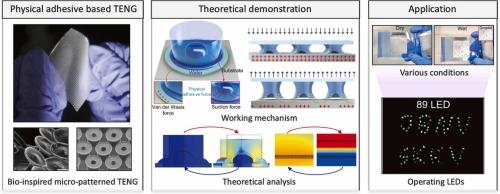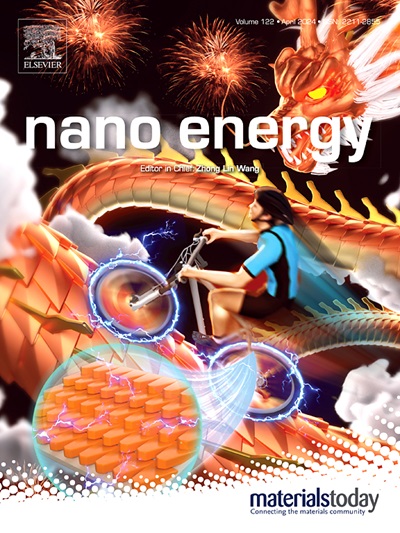结合仿生三维表面结构实现吸力强迫三电能升级
IF 16.8
1区 材料科学
Q1 CHEMISTRY, PHYSICAL
引用次数: 0
摘要
根据静电感应和三电化原理运行的三电纳米发电机(TENGs)已成为极具前景的能量收集设备,为应对能源枯竭的挑战提供了巨大的潜力。在本研究中,我们提出了一种分层生物启发架构,旨在通过物理粘合机制增强三电效应,并通过创建高度可变形的三维微结构来实现。这种三维(3D)结构受到雄性潜水甲虫的启发,其特点是在干燥和潮湿环境中都能与电极表面形成保形接触,从而增加界面的接触面积和可压缩性。这种结构增强了范德华力,并在界面上产生多种物理粘附力,从而实现显著的电荷转移。与平面以及各种三维生物启发结构(如线形柱和蘑菇状结构)相比,潜水甲虫启发结构的三电性能最高,在干燥条件下,16 N 的力可产生电压(约 42 V)和电流(约 1008 nA)。这项研究的结果提供了一个新的视角,证明了与依赖无结构设计或化学粘合剂的传统 TENG 相比,通过战略性地设计物理粘合结构可以有效地产生三电能。本文章由计算机程序翻译,如有差异,请以英文原文为准。

Suction-forced triboelectricity escalation by incorporating biomimetic 3-dimensional surface architectures
Triboelectric nanogenerators (TENGs), which operate on the principles of electrostatic induction and triboelectrification, have emerged as highly promising devices for energy harvesting, offering vast potential to address the challenges of energy depletion. In this study, we present a hierarchical bio-inspired architecture designed to enhance the triboelectric effect through a physically adhesive mechanism, achieved by creating a highly deformable 3D microstructure. This three-dimensional (3D) architecture, inspired by the male diving beetle, features properties that increase the contact area and compressibility of the interface by forming conformal contact with the electrode surface in both dry and wet environments. The architecture enhances van der Waals forces and generates multiple physical adhesion forces at the interface, leading to significant charge transfer. Compared to flat surfaces as well as various 3D bio-inspired architectures such as linear-shaped pillars and mushroom-like architectures, diving beetle inspired architecture demonstrated the highest triboelectric performance, generating voltage (~42 V) and current (~1008 nA) in dry conditions at 16 N of force. The results of this study offer a new perspective, demonstrating that triboelectricity can be efficiently generated through the strategic design of physically adhesive structures, as opposed to conventional TENGs that rely on structureless designs or chemical adhesives.
求助全文
通过发布文献求助,成功后即可免费获取论文全文。
去求助
来源期刊

Nano Energy
CHEMISTRY, PHYSICAL-NANOSCIENCE & NANOTECHNOLOGY
CiteScore
30.30
自引率
7.40%
发文量
1207
审稿时长
23 days
期刊介绍:
Nano Energy is a multidisciplinary, rapid-publication forum of original peer-reviewed contributions on the science and engineering of nanomaterials and nanodevices used in all forms of energy harvesting, conversion, storage, utilization and policy. Through its mixture of articles, reviews, communications, research news, and information on key developments, Nano Energy provides a comprehensive coverage of this exciting and dynamic field which joins nanoscience and nanotechnology with energy science. The journal is relevant to all those who are interested in nanomaterials solutions to the energy problem.
Nano Energy publishes original experimental and theoretical research on all aspects of energy-related research which utilizes nanomaterials and nanotechnology. Manuscripts of four types are considered: review articles which inform readers of the latest research and advances in energy science; rapid communications which feature exciting research breakthroughs in the field; full-length articles which report comprehensive research developments; and news and opinions which comment on topical issues or express views on the developments in related fields.
 求助内容:
求助内容: 应助结果提醒方式:
应助结果提醒方式:


